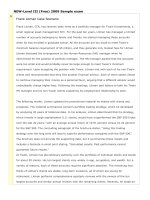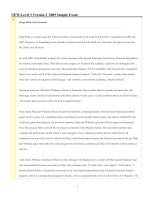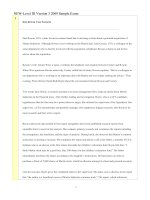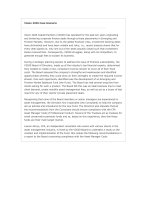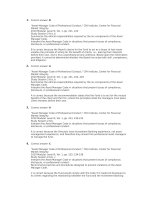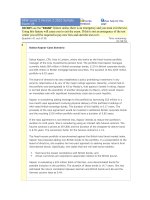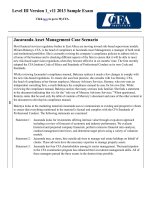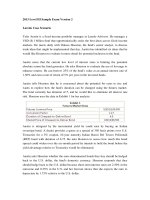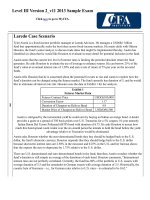2009 l3 sample exam v1 qa
Bạn đang xem bản rút gọn của tài liệu. Xem và tải ngay bản đầy đủ của tài liệu tại đây (157.32 KB, 26 trang )
NEW-Level III (Free) 2009 Sample exam
1
Frank Litman Case Scenario
Frank Litman, CFA, has recently been hired as a portfolio manager for Twain Investments, a small
regional asset management firm. For the past ten years, Litman has managed a limited number
of accounts belonging to family and friends. He started managing these accounts when he was
enrolled in graduate school. All the accounts are too small to meet Twain’s minimum balance
requirement of $5 million, and they generate only modest fees for Litman. Litman disclosed the
arrangement to the Human Resources (HR) manager when he interviewed for the position of
portfolio manager. The HR manager agreed that the accounts were too small and would probably
never be large enough to meet Twain’s minimum requirement. Upon accepting the position with
Twain, Litman met with each of his non-Twain clients and recommended that they find another
financial advisor. Each of them asked Litman to continue managing their money as a personal
favor, arguing that a different advisor would undoubtedly charge higher fees. Following the
meetings, Litman sent letters to both his Twain HR manager and his non-Twain clients explaining
his employment relationship to each.
The following month, Litman updated the promotional material he shares with clients and
prospects. The material summarizes Litman’s portfolio trading strategy, which he developed by
analyzing 20 years of historical data. In his analysis, Litman determined that his strategy, which
invests in large-capitalization U.S. stocks, would have outperformed the S&P 500 Index over the
last 20 years—with an average annual return of 10.91 percent versus 10.42 percent for the S&P
500. The concluding paragraph of the brochure states, "Using this trading strategy over the long
term will lead to superior performance compared with the S&P 500." The brochure does not
provide the supporting data, but it summarizes these results and includes a footnote in small
print stating, “Simulated results. Past performance cannot guarantee future results.”
At Twain, Litman has discretionary authority over the portfolios of individual stocks and bonds for
about 30 clients. His ten largest clients vary widely in age, occupation, and wealth. For a variety
of reasons, each of these accounts requires significant attention. The remaining two-thirds of
Litman’s clients are stable, long-term investors, all of whom are saving for retirement. Litman
performs comprehensive quarterly reviews with the owners of the ten largest accounts and
similar annual reviews with the remaining clients. Recently, he made an exception to this rule
when he learned that one of his smaller, less active clients had unexpectedly inherited $600,000
from an aunt’s estate. Litman met with the client and performed a comprehensive review of the
client’s financial situation even though only three months had passed since their last meeting.
With a new CEO, Twain, which adheres to the Asset Manager Code of Professional Conduct,
experiences significant change during the year when management hires a compliance officer.
The compliance officer immediately begins to update the firm's policies and procedures. After a
thorough analysis, the firm decides to outsource its back-office operations and hires an
independent consultant to review client portfolio information. At the same time, they add several
research and investment staff and upgrade the information management system. They eliminate
paper records in favor of electronic copies and develop a business-continuity plan based on
current staffing.
Eighteen months later, the compliance officer resigns. Rather than hire externally, management
designates one of its senior portfolio managers as the new compliance officer. The compliance
officer reviews both firm and employee transactions and reports to the chief investment officer.
Question 1
According to CFA Institute Standards, for Litman to comply with the Standards in regards to Twain and
non-Twain clients, he must do which of the following?
Select exactly 1 answer(s) from the following:
A. Inform his immediate supervisor.
B. Obtain written consent from both Twain and his non-Twain clients.
C. Nothing more as he has already informed Twain management and his non-Twain clients
explaining the relationship.
Correct Answer = B
"Guidance" for Standards I — VII, CFA Institute
2009 Modular Level III, Vol. 1, pp. 75, 89-91
Study Session 1-2-a
Demonstrate a thorough knowledge of the Code of Ethics and Standards of Professional Conduct by
interpreting the Code and Standards in various situations involving issues of professional integrity.
According to Standard IV (B), Duties to Employers: Additional Compensation Arrangements, Litman
must obtain written permission from all parties involved.
2 According to CFA Institute Standards and Procedures for Compliance, which of the following
information in regards to Litman managing funds for his family and friends is least likely required for
him to comply with the Duty to Employer?
Select exactly 1 answer(s) from the following:
A. The names of his non-Twain clients.
B. The amount and type of compensation received.
C. The duration of the investment management agreements.
Correct Answer = A
"Guidance" for Standards I — VII, CFA Institute
2009 Modular Level III, Vol. 1, pp. 67, 75
Study Session 1-2-a
Demonstrate a thorough knowledge of the Code of Ethics and Standards of Professional Conduct by
interpreting the Code and Standards in various situations involving issues of professional integrity.
According to the recommended Procedures for Compliance for Standard IV (B), Duties to Employers:
Additional Compensation Arrangements, members should disclose the terms of any agreement under
which a member will receive additional compensation. Terms include the nature of the compensation,
the approximate amount of compensation, and the duration of the agreement because such
arrangement may affect loyalties and objectivity, thus creating a potential conflict of interest.
According to Standard III (E), Duties to Clients: Preservation of Confidentiality, members must keep
information about current and prospective clients confidential.
3 In his promotional material about the performance of his portfolio trading strategy, is Litman in
compliance with CFA Institute Standards of Professional Conduct with respect to the footnote?
Select exactly 1 answer(s) from the following:
A. Yes.
B. No, because he doesn't state whether the results are net or gross of fees.
C. No, because he should not be using simulated results to make a comparison.
Correct Answer = A
"Guidance" for Standards I — VII, CFA Institute
2009 Modular Level III, Vol. 1, pp. 64- 65
Study Session 1-2-a
Demonstrate a thorough knowledge of the Code of Ethics and Standards of Professional Conduct by
interpreting the Code and Standards in various situations involving issues of professional integrity.
The footnote is a standard disclaimer regarding the performance numbers presented (simulated)
as well as expectations of the future in that past results do not necessarily reflect future
performance. The Code does not prohibit the use of simulated performance analysis as long as it is
clearly stated that the results are simulated.
4 Did Litman violate any CFA Institute Standards in regards to his performance reviews?
Select exactly 1 answer(s) from the following:
A. No.
B. Yes, with respect to the frequency of reviews for his ten largest clients.
C. Yes, with respect to his recent review for the client with the inheritance.
Correct Answer = A
2009 Modular Level III, Vol. 1, pp. 60-62
Study Session 1-2-a
Demonstrate a thorough knowledge of the Code of Ethics and Standards of Professional Conduct by
interpreting the Code and Standards in various situations involving issues of professional integrity.
According to Standard III (C), Duties to Clients: Suitability, members shall make a reasonable inquiry
into a client or prospective client's investment experience, risk and return objectives, and financial
constraints prior to making any investment recommendations or taking investment action and must
update this information regularly. Such an inquiry should be repeated at least annually and prior to
material changes to specific investment recommendations or decisions on behalf of the client.
5 Are Twain's actions and procedures during the first year of the new CEO's tenure in compliance
with the Asset Manager Code of Professional Conduct?
Select exactly 1 answer(s) from the following:
A. Yes.
B. No, because it outsourced its back-office operations.
C. No, because by hiring an independent consultant it violates client confidentiality.
Correct Answer = A
Asset Manager Code of Professional Conduct: Compliance and Support, including Appendix A
(CFA Institute, Centre for Financial Market Integrity, 2005)
2009 Modular Level III, Vol. 1, pp. 194-195, 203
Study Session 2-6-b
Interpret the Asset Manager Code in situations presenting issues of compliance, disclosure, or
professional conduct.
The Code allows outsourcing, although managers retain the liability and responsibility for any
outsourced work. Managers have a responsibility to ensure that the information they provide to
clients is accurate and complete. By receiving an independent third-party confirmation or review
of that information, clients can have an additional level of confidence that the information is
correct and can enhance the Manager's credibility. Such verification is also good business
practice.
6 With respect to its most recent compliance officer, are Twain's actions and procedures in
compliance with the recommendations and requirements of the Asset Manager Code of
Professional Conduct?
Select exactly 1 answer(s) from the following:
A. Yes.
B. No, because the compliance officer should not be an existing employee.
C. No, because the compliance officer should not report to the chief investment officer.
Correct Answer = C
Asset Manager Code of Professional Conduct: Compliance and Support, including Appendix A (CFA
Institute, Centre for Financial Market Integrity, 2005)
2009 Modular Level III, Vol. 1, pp. 210-211
Study Session 2-6-b
Interpret the Asset Manager Code in specific situations presenting issues of compliance, disclosure,
or professional conduct.
According to the Code, the compliance officer should report directly to the CEO or board of directors
so that this person is independent from the investment personnel. Depending on the size and
complexity of the Manager's operations, some Managers may designate an existing employee to
also serve as the compliance officer.
7
Dena Pearson Case Scenario
Dena Pearson is a recent hire at a large international bank. She is currently working a rotation in
the Risk Management Group, where she has received several assignments.
For her first assignment, Pearson must draft a response to an inquiry from a client seeking
information about value at risk or VAR. The client’s email stated:
“This month’s report states that using a 95 percent confidence level, the
portfolio has an average daily VAR of $1 million. I need clarification on what
this means. I would also like to understand what would happen to the VAR
measure if the confidence level was increased to 99 percent and the
frequency was changed from daily to monthly.
In the notes, the report states that the VAR is based on the analytical or
variance-covariance method. What are the key advantages and
disadvantages of this method? Why doesn't the bank use the historical
simulation method or the Monte Carlo simulation method?”
Pearson drafts a response to the client’s questions. In her response, she states:
“Assuming 250 trading days in a year, the current VAR estimate indicates that
the daily portfolio loss will likely exceed $1 million approximately twelve to
thirteen times over a period of one year. Switching to a 99 percent confidence
level would provide a less conservative VAR estimate.”
Later in the response, she writes:
"Disadvantages of the historical simulation method include that the model:
1) is nonparametric,
2) relies completely on events of the past, and
3) applies historical price changes to the current portfolio.
The chief disadvantage of the Monte Carlo method is that it relies on
historical data to generate outcomes based on a normal probability
distribution. For these reasons, we prefer the analytical method."
Pearson's second assignment is to evaluate the credit risk of several positions, including:
1. A call option the bank purchased from a dealer for $30. The current market
price of the option is $35.
2. A short position in a one-year forward contract with a forward price of $200
that has six months remaining until expiry. The forward price was
determined based on a risk-free rate of 5.5 percent. The current spot price of
the underlying asset is $207.
Question #7 out of 30
Pearson's draft response to the client clarifying the meaning of the current VAR measure is:
Select exactly 1 answer(s) from the following:
A. correct.
B. incorrect, because VAR represents a maximum loss that will not be exceeded.
C. incorrect, because over a full year, the VAR will be larger than the amount for a single
day.
Correct Answer = A
"Risk Management," Don M. Chance, Kenneth Grant, and John Marsland
2009 Modular Level III, Vol. 5, pp. 211-213
Study Session 14-40-e, g
Interpret and compute value at risk (VAR) and explain its role in measuring overall and individual
position market risk.
Discuss the advantages and limitations of VAR and its extensions, including cash flow at risk,
earnings at risk, and tail value at risk.
Assuming 250 trading days per year, if daily VAR at 95 percent confidence level (violated 5 percent
of the time) is $1 million, over one year a daily loss exceeding $1 million should occur approximately
5 percent of 250 days or 12.5 days.
8 To address the client's question regarding a shift from a daily to a monthly VAR measure,
Pearson's most accurate response would be that the VAR estimate for the portfolio would:
Select exactly 1 answer(s) from the following:
A. increase.
B. decrease.
C. not change.
Correct Answer = A
"Risk Management," Don M. Chance, Kenneth Grant, and John Marsland
2009 Modular Level III, Vol. 5, pp. 211-213
Study Session 14-40-e
Interpret and compute value at risk (VAR) and explain its role in measuring overall and individual
position market risk.
The longer the time period chosen, the greater the VAR number will be because the magnitude of
potential losses varies directly with the time span over which they are measured.
9 Pearson decides to expand her answer regarding the bank's method for estimating VAR to add
discussion about the key advantages of the analytical method. One of the key advantages of the
analytical method that she could discuss is the:
Select exactly 1 answer(s) from the following:
A. simplicity of the method.
B. assumption that returns are normally distributed.
C. ability to incorporate optionality into the analysis.
Correct Answer = A
"Risk Management," Don M. Chance, Kenneth Grant, and John Marsland
2009 Modular Level III, Vol. 5, pp. 213-218
Study Session 14-40-f
Compare and contrast the analytical (variance-covariance), historical, and Monte Carlo methods for
estimating VAR and discuss the advantages and disadvantages of each.
The model for the analytical method uses readily available data and simple calculations.
10
Are Pearson's three statements regarding the disadvantages of the historical method for
estimating VAR correct?
Select exactly 1 answer(s) from the following:
A. Yes.
B. No, the first statement is not a disadvantage.
C. No, the third statement is not a disadvantage.
Correct Answer = B
"Risk Management," Don M. Chance, Kenneth Grant, and John Marsland
2009 Modular Level III, Vol. 5, pp. 218-221
Study Session 14-40-f
Compare and contrast the analytical (variance-covariance), historical, and Monte Carlo methods for
estimating VAR and discuss the advantages and disadvantages of each.
The nonparametric feature of the historical method is an advantage, not a disadvantage. The
historical method requires minimal probability-distribution assumptions compared to other methods.
11 For the bank's long call option position, Pearson's most appropriate estimate of the amount at
risk of a credit loss is:
Select exactly 1 answer(s) from the following:
A. $0.
B. $30.
C. $35.
Correct Answer = C
"Risk Management," Don M. Chance, Kenneth Grant, and John Marsland
2009 Modular Level III, Vol. 5, pp. 234-236
Study Session 14-40-i
Evaluate the credit risk of an investment position, including forward contract, swap, and option
positions.
The current failure (e.g., bankruptcy) of the option seller would mean the option holder (the bank)
would lose the entire market value.
12 For the forward contract position, Pearson's most appropriate estimate of the amount of
potential credit risk is:
A. $0.
B. $1.53.
C. $12.28.
Correct Answer = A
"Risk Management," Don M. Chance, Kenneth Grant, and John Marsland
2009 Modular Level III, Vol. 5, pp. 232-233
Study Session 14-40-i
Evaluate the credit risk of an investment position, including forward contract, swap, and
option positions.
The value of the long position is +$12.28 = $207 — $200 / (1.055) 0.5. This means the short
(the bank) owes the long, so the short (the bank) has no credit risk.
13
Bae Chung Case Scenario
Bae Chung, CFA, is the owner of Kyung Securities, a small boutique firm that manages US$4.2
billion in leveraged fixed income portfolios for clients. Chung has been meeting with
managers of a pension fund that is interested in placing $500 million under Kyung's
management and is preparing a proposal for them.
At a meeting with the pension fund's representatives, Chung was asked to explain Kyung's
use of leverage. Chung replied, "We use the repo market to borrow against client assets
and leverage up portfolio returns. Our mandate allows us to borrow between 0 and 75
percent of the equity of the portfolio, depending on our market outlook." Bae then makes
the following statements:
Statement 1:
"In the current market, our average client portfolio has an expected asset
return of 7.40 percent, our average portfolio leverage is 40 percent, and we
pay 4.25 percent in the repo market."
Statement 2:
"We place client assets that are used in these repurchase agreements in a
custodial account at our bank, rather than using wire transfer of title. This
delivery method results in lower delivery charges and lower repo rates."
The proposal that Chung is creating discusses Kyung's fixed income investment philosophy:
"We seek the highest risk-adjusted returns by purchasing bonds and other fixed income
securities that our models indicate are underpriced with respect to credit risk
characteristics. Our investment policy requires that we purchase only investment grade
(BBB-rated or higher) securities and sell any security that is downgraded to speculative
grade. Further, our policy requires that we use derivatives to hedge credit risk for any
position rated below A. We do not consider a client's target duration until after the portfolio
is formed, at which time we use interest rate futures contracts to modify the duration of the
portfolio, as necessary."
Chung develops an example of changing a portfolio's duration based on the data in Exhibit
1.
Exhibit 1
Bond Portfolio and Bond Futures Data
Portfolio value
$10,000,000
Portfolio duration
6.5 years
Target duration
9.0 years
Price of cheapest to deliver bond
$98,000
Duration of cheapest to deliver bond
8.62
Conversion factor for cheapest to deliver bond
1.15
Based on earlier discussions with the pension fund's managers, Chung was prepared to
recommend a model portfolio with a duration of 5.0 years, measured against U.S. interest
rates. More recently, Chung was told that the pension fund owns $100 million worth of
Australian bonds that must be included in the portfolio for the next year. These bonds have
a duration of 3.2 years and Chung estimates that Australia's country beta is 0.80. The
expected (local currency) return on the bonds is 8.50 percent, and the 1-year risk-free
yields are 1.3 percent in the U.S. and 4.6 percent in Australia. The spot exchange rate is
USD0.69/AUD and the one year forward rate is USD0.67/AUD.
Chung's proposal includes a recommendation that the pension fund consider adding
exposure to emerging markets. The recommendation states that, "Many investors avoid
emerging fixed income markets to their detriment. On average, the returns earned in these
markets exceed those earned in developed countries and downside risks are compensated
with equally large upside potential."
The proposal concludes with a review of Kyung Securities' performance
during the last three years. It indicates that, on average, Kyung's signature
core-plus portfolio has produced alpha of 35 bps against fees of 22 bps with
tracking error of 150 bps.
Question 13
Based on Statement 1, the expected return of Kyung's average client portfolio is closest to:
Select exactly 1 answer(s) from the following:
A. 8.66%.
B. 10.55%.
C. 11.81%.
Correct Answer = A
"Fixed-Income Portfolio Management — Part II," H. Gifford Fong and Larry D. Guin, CFA
2009 Modular Level III, Vol. 4, pp. 98-100
Study Session 10-31-a
Evaluate the effects of leverage on portfolio returns.
RP = rF + (B / E) × (rF — k), where RP = portfolio rate of return, where rF = return on funds invested,
B = amount of borrowed funds, E = amount of equity, and k = cost of borrowing. Assuming $100
invested, then,
14
Chung's Statement 2 regarding delivery of assets in repurchase agreements is most likely:
Select exactly 1 answer(s) from the following:
A. correct.
B. incorrect, because repo rates are lower for electronic (wire) transfer of title.
C. incorrect, because delivery charges are lower for electronic (wire) transfer of
title.
Correct Answer = B
"Fixed-Income Portfolio Management — Part II," H. Gifford Fong and Larry D. Guin, CFA
2009 Modular Level III, Vol. 4, pp. 101-103
Study Session 10-31-b
Discuss the use of repurchase agreements (repos) to finance bond purchases and the factors that
affect the repo rate.
Repo rates will reflect the delivery requirement, with (all else the same) the lowest rates provided for
physical delivery, the next lowest for wire transfer of title, the next for delivery to a custodial
account, and the highest for no delivery. Delivery charges are the reverse of this, with the highest for
physical delivery, lower for wire transfer, lower still for delivery to a custodial account, and none for
no delivery.
15
Chung's proposal mentions the use of derivatives to hedge credit risk.
Given Kyung's policy, which of the following instruments would most likely
be used?
Select exactly 1 answer(s) from the following:
A. Binary credit options.
B. Credit spread options.
C. Credit spread forwards.
Correct Answer = A
"Fixed-Income Portfolio Management — Part II," H. Gifford Fong and Larry D. Guin, CFA
2009 Modular Level III, Vol. 4, pp. 115-120
Study Session 10-31-f
Compare and contrast default risk, credit spread risk, and downgrade risk, and demonstrate the use
of credit derivatives to address each risk in the context of a fixed income portfolio.
According to the vignette, Kyung's policy requires that bonds whose ratings fall from BBB to BB be
sold and that bonds with BBB ratings be hedged. This means that the portfolio must be protected
from downgrade risk, requiring the use of a binary credit put option that pays the holder if the
bond's rating falls below investment grade.
A credit spread option is inappropriate, because credit spreads can widen or tighten due to general
market conditions, rather than specific ratings changes. A credit spread forward is even more
inappropriate because it exposes the portfolio to losses if the spreads tighten, which will happen if
Kyung's models are correct and the securities purchased are indeed undervalued.
16
According to the data in Exhibit 1, the number of futures contracts that must be purchased to
meet the portfolio's target duration is closest to:
Select exactly 1 answer(s) from the following:
A. 26.
B. 30.
C. 34.
Correct Answer = C
"Fixed-Income Portfolio Management — Part II," H. Gifford Fong and Larry D. Guin, CFA
2009 Modular Level III, Vol. 4, pp. 108-110
Study Session 10-31-d, e
Demonstrate the advantages of using futures instead of cash market instruments to alter portfolio
risk.
Construct and evaluate an immunization strategy based on interest rate futures.
The approximate number of contracts needed to meet a specific target duration is defined as:
where DT is the target duration, DI is the initial portfolio duration, PI is the initial value of the
portfolio, DCTD is the duration of the cheapest to deliver bond, and P CTD is the price of the cheapest
to deliver bond. Then,
17
The contribution to the portfolio's duration from the Australian bond is closest to:
Select exactly 1 answer(s) from the following:
A. 0.51 years.
B. 1.44 years.
C. 2.56 years.
Correct Answer = A
"Fixed-Income Portfolio Management — Part II," H. Gifford Fong and Larry D. Guin, CFA
2009 Modular Level III, Vol. 4, pp. 123-124 (especially example 16)
Study Session 10-31-h
Analyze the change in value for a foreign bond when domestic interest rates change, given the
bond's duration and the country beta, and analyze the contribution of a foreign bond to a domestic
portfolio's duration, given the duration of the foreign bond and the country beta.
A portfolio's duration is the weighted average of the duration of the bonds in the portfolio. First
calculate the adjusted duration, which equals the foreign bond's duration multiplied by the country
beta, or 3.2 × 0.8 = 2.56. Then multiply this result by the bond's weight in the portfolio:
18 Given the exchange rate and interest rate data provided, if the Australian currency risk is fully
hedged, the bond's return will be closest to:
Select exactly 1 answer(s) from the following:
A. 3.90%.
B. 5.20%.
C. 5.60%.
Correct Answer = C
"Fixed-Income Portfolio Management — Part II," H. Gifford Fong and Larry D. Guin, CFA
2009 Modular Level III, Vol. 4, pp. 127-129
Study Session 10-31-i
Recommend and justify whether to hedge or not hedge an international bond investment.
The hedged return is defined as the local return of the bond plus the forward discount or premium,
or:
where F is the forward rate and S is the spot rate.
The hedged return is therefore the local return less the cost of the hedge or 8.50% — 2.90% =
5.60%.
19
Gail Knight Case Scenario
Gail Knight, CFA, is the Chief Investment Officer of a large pension fund that currently
holds only long positions in domestic equities and fixed-income securities. The
Investment Committee is meeting with Stuart Lytle, a consultant hired to research
alternative investments. Moshe Arbel, the committee chairperson, tells Lytle: “Our goal is
to increase the fund’s diversification by adding real estate and commodities to the
investment portfolio.” Lytle has gathered historical real estate performance data, which
is presented in Exhibit 1.
Exhibit 1
Real Estate Performance
1990–2007
Annualized
Measure
NAREIT
NAREIT
NCREIF
NCREIF
Index
Index Hedged
Index
Index
Unsmoothed
Return
12.43%
8.76%
6.03%
7.11%
Standard
12.86%
12.05%
3.41%
9.03%
Deviation
He explains that the National Association of Real Estate Investment Trusts (NAREIT)
Index measures the performance of indirect real estate investment, while the National
Association of Real Estate Investment Fiduciaries (NCREIF) Index measures the
performance of direct real estate investment. Lytle goes on to state:
“Compared to the NAREIT Index, the NAREIT Index Hedged is a better measure of
indirect real estate performance because it excludes the effects of interest rate changes.
The performance of direct real estate investment can be measured using the NCREIF
Index. However, the NCREIF Index Unsmoothed is better than the NCREIF Index because
it corrects for the sale valuation bias.”
Lytle then presents additional information to demonstrate the diversification benefits of
real estate investment. This information is presented in Exhibit 2.
Exhibit 2
Diversification Impact of Real Estate
1990–2007
Component
Portfolio 1
Portfolio 2
Portfolio 3
Equity
50%
40%
40%
Bonds
50%
40%
40%
NAREIT
---
20%
---
NCREIF Unsmoothed
---
---
20%
Return
9.60%
10.34%
9.33%
Standard Deviation
7.87%
7.62%
6.59%
Annualized Measure
In addition, T-Bills currently yield 1.5 percent per year.
Lytle then makes the following statement.
“Adding direct real estate investments to a portfolio of equity and fixed income
securities provides more diversification benefits than adding indirect real estate
investments."
Later in the meeting, Lytle discusses commodities, explaining that in addition to
providing diversification benefits, they perform well during periods of inflation. Arbel
asks if investing in commodities requires their physical purchase. Lytle replies:
“No, often the easiest way to gain exposure to commodity prices is by investing in
commodity-linked companies. However, derivative products such as commodity
futures contracts provide effective exposure to commodity price changes as well.”
Arbel then asks if a reason commodity futures contracts perform well during periods of
inflation is because the underlying commodities are linked to price indices. Lytle replies:
“Yes, commodities do match components of price indices and storable commodities
such as crude oil exhibit positive correlation with unexpected inflation. Commodity
futures prices are affected more by long-term expectations than by stock and bond
prices."
Lytle goes on to outline sources of return associated with commodity futures contracts:
“A commodity futures contract buyer earns a collateral yield on the margin provided
to buy the contract. The roll yield is a potential source of return for a commodity
index. However, for commodity index returns to benefit from roll yield the market
must be in backwardation."
Question #19 out of 30
Are Lytle's statements regarding the characteristics or construction of the NAREIT Index and
the NAREIT Index Hedged correct?
Select exactly 1 answer(s) from the following:
A. Yes.
B. Only the NAREIT Index statement is correct.
C. Only the NAREIT Index Hedged statement is correct.
Correct Answer = B
"Alternative Investments Portfolio Management," Jot K. Yau, Thomas Schneeweis, Thomas R.
Robinson, and Lisa R. Weiss
2009 Modular Level III, Vol. 5, pp. 16-19
Study Session 13-37-e
Discuss the construction and interpretation of benchmarks and the problem of benchmark bias in
alternative investment groups.
The NAREIT is a market-weighted index of all actively traded NYSE REITs and represents indirect
investment in real estate.
20
Are Lytle's statements regarding the NCREIF Index and the NCREIF Index Unsmoothed most
likely correct?
Select exactly 1 answer(s) from the following:
A. Yes.
B. No, he is incorrect about the NCREIF Index Unsmoothed.
C. No, he is incorrect about what the NCREIF Index measures.
Correct Answer = A
"Alternative Investments Portfolio Management," Jot K. Yau, Thomas Schneeweis, Thomas R.
Robinson, and Lisa R. Weiss
2009 Modular Level III, Vol. 5, pp. 16-19
Study Session 13-37-e
Discuss the construction and interpretation of benchmarks, including biases, in alternative
investment groups.
Lytle's statements about the NCREIF Index and the NCREIF Index Unsmoothed are both correct.
21
With respect to the real estate performance data in Exhibit 1, the most likely explanation for differe
NCREIF Index and the other indices is because:
Select exactly 1 answer(s) from the following:
A. of infrequent property valuations.
B. only nonleveraged investment is represented.
C. the overall equity market component has been removed.
Correct Answer = A
"Alternative Investments Portfolio Management," Jot K. Yau, Thomas Schneeweis, Thomas R.
Robinson, and Lisa R. Weiss
2009 Modular Level III, Vol. 5, pp. 18-19
Study Session 13-37-e
Discuss the construction and interpretation of benchmarks and the problem of benchmark bias in
alternative investment groups.
Real estate properties change hands relatively infrequently and appraisals are typically conducted
only once per year. As a consequence, the returns calculated on the basis of these stale valuations
underestimate the volatility of the index.
22 Based on information provided in Exhibit 2, Lytle's statement about the relative benefits of
direct versus indirect real estate investment is most likely correct because the portfolio with
direct real estate investment has the:
Select exactly 1 answer(s) from the following:
A. highest returns.
B. highest Sharpe ratio.
C. lowest standard deviation.
Correct Answer = B
"Alternative Investments Portfolio Management," Jot K. Yau, Thomas Schneeweis, Thomas R.
Robinson, and Lisa R. Weiss
2009 Modular Level III, Vol. 5, pp. 21-27
Study Session 13-37-f
Evaluate and justify the return enhancement and/or risk diversification effects of adding an
alternative investment to a reference portfolio (for example, a portfolio invested solely in common
equity and bonds).
Portfolio 3 has 20 percent in direct real estate investment (NCREIF Unsmoothed) and it has the
highest Sharpe ratio of 1.19 = (9.33 — 1.5) / 6.21.
23
Lytle's response to Arbel's question about investing commodities through physical assets
is most likely:
Select exactly 1 answer(s) from the following:
A. incorrect.
B. correct only with respect to commodity futures contracts.
C. correct only with respect to commodity-linked companies.
Correct Answer = B
"Alternative Investments Portfolio Management," Jot K. Yau, Thomas Schneeweis, Thomas R.
Robinson, and Lisa R. Weiss
2009 Modular Level III, Vol. 5, pp. 47-48
Study Session 13-37-m
Compare and contrast indirect and direct commodity investment.
To the degree that commodity linked companies hedge a major portion of their commodity risk,
they may actually have low correlations with commodity price movements. Consequently,
commodity futures are a more effective way to gain exposure to commodity price changes.
24
Are Lytle's comments about commodity futures contract returns correct?
Select exactly 1 answer(s) from the following:
A. Yes.
B. Only with respect to the roll yield.
C. Only with respect to the collateral yield.
Correct Answer = A
"Alternative Investments Portfolio Management," Jot K. Yau, Thomas Schneeweis, Thomas R.
Robinson, and Lisa R. Weiss
2009 Modular Level III, Vol. 5, pp. 48-56
Study Session 13-37-n
Explain the three components of return for a commodity futures contract and the effect that an
upward- or downward-sloping term structure of futures prices will have on roll yield.
Collateral yield comes from the assumption that the full value of the underlying futures contract is
invested to earn the risk-free interest rate and the long futures contract holder earns a positive roll
yield when the commodity futures is in backwardation.
25
Mike Spong Case Scenario
Jennifer Simko’s fixed income portfolio has underperformed its benchmark, the
Lehman Aggregate Bond Index. Simko has asked her investment advisor, Mike
Spong, to recommend a new fixed income manager. Spong has selected three fixed
income portfolio managers for Simko to consider:
•
Indicia Fixed Income Management, an index manager
•
Augmented Fixed Income Management, an enhanced index manager
•
Vertex Fixed Income Management, an active manager
Selected characteristics for each manager’s portfolio are provided in Exhibit 1.
Exhibit 1
Selected Portfolio Characteristics for the Benchmark Portfolio
and Three Potential Fixed-Income Managers
Percent of Market Value
Sector
Duration
Benchm Indicia Augmen Vertex Benchm Indicia Augmen Vertex
ark
ted
ark
ted
Treasury
25
25
20
15
5.2
5.2
5.0
5.3
Agency
11
11
11
0
3.6
3.6
3.6
0.0
Credit
25
25
30
24
5.6
5.6
5.3
4.6
Mortgage
34
34
35
43
4.4
4.4
4.6
4.0
2
2
0
2
0.0
0.0
0.0
10.0
CMBS
3
3
4
8
3.3
3.3
2.5
6.3
Cash
0
0
0
8
0.0
0.0
0.0
0.0
Total
100
100
100
100
4.7
4.7
4.7
4.3
$80
$120
$100
Assetbacked
Total MV
(millions)
Spong makes the following statements to Simko regarding Exhibit 1:
1. “Indicia’s portfolio performance will match the fixed income benchmark’s
performance because Indicia’s portfolio sector weights, duration, convexity, and
term structure match those of the benchmark. Augmented’s portfolio
characteristics do not match the benchmark’s because Augmented has minor risk
factor mismatches typically associated with an enhanced index manager. Vertex’s
portfolio is intentionally constructed to have greater mismatches compared with
the benchmark and uses value-added strategies in an effort to improve
performance. None of the managers utilize leverage in their portfolios.”
2. “As an active manager Vertex's objectives are to ensure that tracking risk is
always minimized and that portfolio duration matches benchmark duration."
3. “Vertex measures a bond’s expected total return using a single set of
assumptions in its horizon analysis. This is the most appropriate method to
compute a bond’s total return over an investor’s time horizon. In a recent
expected total return calculation, for example, Vertex used, for a single bond, a
beginning price of $103, a 5 percent coupon paid semiannually, an expected price
at the end of one year of $102.5, and an annual reinvestment rate of 2 percent.”
4. “Vertex also positions the portfolio to reflect the firm’s opinions on the direction of
interest rates and yield spreads. Over the next six months Vertex is forecasting:
•
spreads to narrow for all of the spread product sectors, and
•
a positively sloped yield curve with a decline in short rates of 25
basis points and an increase on long rates of 75 basis points."
Question #25 out of 30
Given Augmented's investment style, its most appropriate strategy with respect to
portfolio duration is to:
Select exactly 1 answer(s) from the following:
A. construct a portfolio with duration of zero.
B. match the duration of the portfolio with the duration of the benchmark index.
C. permit a limited degree of mismatch between the duration of the portfolio and
the duration of the benchmark index.
Correct Answer = B
"Fixed-Income Portfolio Management — Part I," H. Gifford Fong and Larry D. Guin, CFA
2009 Modular Level III, Vol. 4, pp. 8-10
Study Session 9-29-b
Discuss the range of index-oriented bond investment strategies and compare and contrast
pure bond indexing, enhanced indexing, and active investing with respect to the objectives,
techniques, advantages, and disadvantages of each.
In Statement 1, Spong states "…Augmented has minor risk factor mismatches typically
associated with an enhanced index manager." The reading states that this strategy matches
the duration of the portfolio with the duration of the benchmark index.
26
Indicia will most likely be prevented from achieving its portfolio performance objective by:
A. the presence of illiquid and infrequently traded securities in the
benchmark.
B. using a multi-factor model technique to match the risk profile of
the benchmark index.
C. using a cell-matching or stratified sampling technique to match
the risk profile of the benchmark index.
Correct Answer = A
"Fixed-Income Portfolio Management — Part I," H. Gifford Fong and Larry D. Guin, CFA
2009 Modular Level III, Vol. 4, pp. 9, 15-17
Study Session 9-29-b, d
Discuss the range of index-oriented bond investment strategies and compare and contrast
pure bond indexing, enhanced indexing, and active investing with respect to the objectives,
techniques, advantages, and disadvantages of each.
Review and justify the means, such as matching duration and key rate durations, by which
an enhanced indexer may seek to align the risk exposures of the portfolio with those of the
benchmark bond index.
Limited availability of securities held in the benchmark will limit Indicia's ability to match the
benchmark performance.
27 In statement 2, are Vertex's objectives with regard to tracking risk and portfolio duration
consistent with their stated strategy?
A. Yes.
B. No, the objectives regarding tracking risk and portfolio duration
are inconsistent with their stated strategy.
C. No, the objective regarding tracking risk is consistent, but the
objective regarding portfolio duration is inconsistent with their
stated strategy.
Correct Answer = B
"Fixed-Income Portfolio Management — Part I," H. Gifford Fong and Larry D. Guin, CFA
2009 Modular Level III, Vol. 4, p. 23
Study Session 9-29-b
Discuss the range of index-oriented bond investment strategies and compare and contrast
pure bond indexing, enhanced indexing, and active investing with respect to the objectives,
techniques, advantages, and disadvantages of each.
As an active manager, Vertex would be willing to accept large tracking errors and
mismatches between portfolio duration and benchmark duration.
28
For the example given in Spong's third statement, the one-year expected total return is
closest to:
A. 4.35%.
B. 4.50%.
C. 4.84%.
Correct Answer = A
"Fixed-Income Portfolio Management — Part I," H. Gifford Fong and Larry D. Guin, CFA
2009 Modular Level III, Vol. 4, pp. 23-24, 27-28
Study Session 9-29-e
Contrast and illustrate the use of total return analysis and scenario analysis to assess the
risk and return characteristics of a proposed trade.
The first step is to calculate the total coupon payments plus reinvestment income. Two
coupon payments are received, one of which is reinvested at half the annual reinvestment
rate, so we have:
Income Flow: $2.50 + ($2.50 × 1.01) = $5.025
The second step is to determine the horizon price that is given in the vignette: $102.5
The third step is to add the income flow and horizon price together to equal horizon future
dollars: $5.025 + $102.5 = $107.525
The fourth step is to calculate the semiannual total return by dividing the total future
dollars by the beginning price: ($107.525 / $103)0.5 — 1.0 = 0.02173 or 2.173%
The final step is to double the semiannual total return to get the total return:
2.173% × 2 = 4.3459%.
29
Given Vertex's interest rate and yield curve forecasts, the most appropriate portfolio would
be a:
A. short duration bullet portfolio.
B. long duration barbell portfolio.
C. laddered portfolio equally invested across all maturities.
Correct Answer = A
"Fixed-Income Portfolio Management — Part I," H. Gifford Fong and Larry D. Guin, CFA
2009 Modular Level III, Vol. 4, pp. 23, 33-39
Study Session 9-29-b, i
Discuss the range of index-oriented bond investment strategies and compare and contrast
pure bond indexing, enhanced indexing, and active investing with respect to the
objectives, techniques, advantages, and disadvantages of each.
Discuss the extensions that have been made to classical immunization theory, including
the introduction of contingent immunization.
Spong's fourth statement indicates that Vertex expects a 25 basis point decline in shortterm rates and a 75 basis point increase in long-term rates. A short duration bullet
strategy is most appropriate to take advantage of this forecast. The bullet will outperform
the barbell because the barbell will experience lower reinvestment rates longer than the
bullet and the barbell will also suffer a large capital loss on the long-term position.
30 The sector allocation strategy that is most appropriate given Vertex's yield spread forecast
is to underweight the:
A. Credit sector and overweight the Mortgage, Asset-backed, and CMBS
sectors.
B. Treasury sector and overweight the Mortgage, Asset-backed, and CMBS
sectors.

